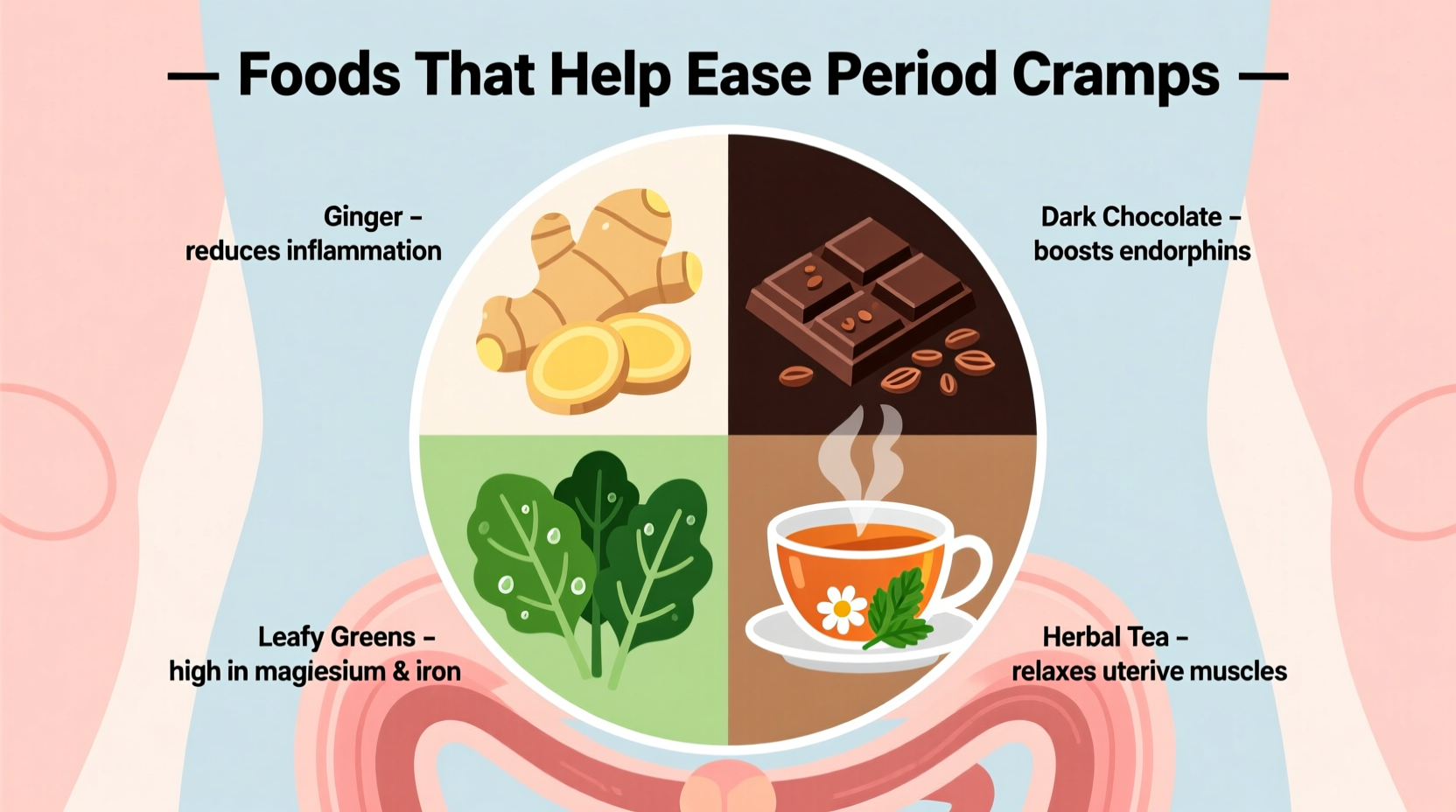The most effective foods for relieving period cramps include magnesium-rich options like dark leafy greens and almonds, omega-3 fatty acid sources such as salmon and flaxseeds, anti-inflammatory spices like ginger and turmeric, and calcium-rich foods including yogurt and fortified plant milks. These foods work by reducing inflammation, relaxing uterine muscles, and counteracting prostaglandins that cause painful contractions. For immediate relief, try a warm ginger tea with honey or a banana-almond smoothie.
Period cramps affect nearly 90% of menstruating individuals at some point in their lives, with about 20% experiencing severe pain that disrupts daily activities. While over-the-counter medications provide relief for many, dietary approaches offer a natural complement that addresses the root causes of menstrual discomfort. This guide reveals science-backed food strategies that can significantly reduce your period pain without side effects.
Why Certain Foods Relieve Menstrual Cramps
Understanding how food affects your menstrual cycle begins with prostaglandins—hormone-like compounds that trigger uterine contractions during your period. Higher prostaglandin levels correlate with more intense cramping. The right foods can reduce inflammation, relax smooth muscle tissue, and balance hormones naturally.
Research from the National Center for Complementary and Integrative Health shows that dietary interventions can reduce menstrual pain severity by 30-50% when implemented consistently across multiple cycles. The key is targeting specific physiological pathways through strategic food choices.
Top 5 Food Categories for Period Cramp Relief
1. Magnesium Powerhouses
Magnesium deficiency directly contributes to muscle tension and cramping. This essential mineral acts as a natural muscle relaxant by blocking calcium channels in uterine tissue.
Most effective options:
- Spinach (1 cup cooked provides 157mg magnesium)
- Almonds (1 ounce contains 80mg)
- Black beans (1/2 cup offers 60mg)
- Avocado (1 medium provides 58mg)
- Dark chocolate (70%+ cacao, 1 ounce has 64mg)
According to a 2019 clinical trial published in the Journal of Obstetrics and Gynaecology, women who consumed 300mg of magnesium daily experienced significantly reduced menstrual pain intensity compared to placebo.
2. Omega-3 Rich Foods
Omega-3 fatty acids reduce inflammation by lowering prostaglandin production. They also help balance omega-6 to omega-3 ratios, which often run imbalanced in Western diets.
| Food Source | Omega-3 Content (per serving) | Best Preparation Method |
|---|---|---|
| Salmon (wild-caught) | 1.8g per 3oz | Baked or grilled (avoid frying) |
| Chia seeds | 5g per 2 tablespoons | Soaked overnight in plant milk |
| Walnuts | 2.5g per 1/4 cup | Raw or lightly toasted |
| Flaxseeds (ground) | 2.4g per 2 tablespoons | Added to smoothies or oatmeal |
A comprehensive meta-analysis in Pain Medicine found that omega-3 supplementation reduced menstrual pain intensity by 38% compared to control groups, with effects becoming more pronounced after three menstrual cycles.
3. Anti-Inflammatory Spices
Ginger and turmeric contain potent compounds that inhibit inflammatory pathways involved in menstrual pain.
Ginger contains gingerols that reduce prostaglandin synthesis. A study in the Journal of Alternative and Complementary Medicine found that 250mg ginger powder taken four times daily reduced menstrual pain as effectively as ibuprofen.
Turmeric provides curcumin, which blocks COX-2 enzymes (the same pathway targeted by NSAIDs). For maximum absorption, combine with black pepper and healthy fats.

4. Calcium-Rich Options
Calcium regulates muscle contractions and nerve signaling. Low calcium levels correlate with increased menstrual pain severity.
Include these calcium sources:
- Fortified plant milks (300mg per cup)
- Yogurt (400mg per 8oz)
- Kale (100mg per cup cooked)
- Almonds (75mg per ounce)
- Canned sardines with bones (325mg per 3oz)
5. Vitamin B6 Foods
Vitamin B6 helps regulate mood and reduce water retention. Research shows it can decrease period pain by supporting neurotransmitter production.
Top sources:
- Chickpeas (1.1mg per cup)
- Tuna (0.9mg per 3oz)
- Bananas (0.4mg per medium)
- Potatoes with skin (0.4mg per medium)
- Sunflower seeds (0.5mg per 1/4 cup)
Foods That Worsen Period Cramps
Certain foods can exacerbate inflammation and fluid retention:
- Processed sugars: Trigger inflammation and blood sugar crashes that worsen cramps
- High-sodium foods: Increase water retention and bloating
- Caffeine: Can tighten blood vessels and increase muscle tension
- Alcohol: Dehydrates and disrupts hormone balance
- Saturated fats: Promote prostaglandin production
Instead of coffee, try warm lemon water with a pinch of sea salt for hydration. Replace sugary snacks with magnesium-rich dark chocolate (70%+ cacao).
Sample Menstrual Relief Meal Plan
This one-day plan targets multiple pain pathways through strategic food timing:
- Morning: Ginger-turmeric smoothie with spinach, banana, chia seeds, and almond milk
- Mid-morning: Handful of almonds and an orange
- Lunch: Salmon salad with mixed greens, avocado, walnuts, and olive oil dressing
- Afternoon: Warm chamomile tea with honey
- Dinner: Lentil soup with kale and sweet potato, side of roasted Brussels sprouts
- Evening: Magnesium-rich dark chocolate square (70%+ cacao)
How Long Until Dietary Changes Work?
Many women report noticeable improvement within one menstrual cycle when consistently implementing these dietary changes. However, research suggests maximum benefits occur after 2-3 cycles as your body adjusts to the new nutrient profile.
| Timeframe | Expected Benefits | Key Actions |
|---|---|---|
| First 24-48 hours | Reduced bloating, immediate cramp relief from ginger/turmeric | Focus on hydration and anti-inflammatory foods |
| One menstrual cycle | 20-30% reduction in pain intensity | Consistent magnesium and omega-3 intake |
| Two menstrual cycles | 35-50% reduction in pain, improved mood | Optimize vitamin B6 and calcium intake |
Complementary Natural Relief Methods
Combine dietary approaches with these evidence-backed strategies:
- Hydration: Drink 2-3 liters of water daily; add electrolytes if experiencing heavy flow
- Heat therapy: Use a heating pad at 104°F (40°C) for 20-minute intervals
- Gentle movement: Try walking or yoga poses like child's pose and cat-cow
- Stress management: Practice deep breathing (4-7-8 technique) to reduce cortisol
When to Consult a Healthcare Provider
Dietary approaches work well for primary dysmenorrhea (common menstrual cramps), but consult a healthcare provider if you experience:
- Pain that disrupts daily activities despite medication
- Sudden onset of severe cramps after age 25
- Pain extending beyond your menstrual period
- Heavy bleeding requiring pad/tampon changes every hour
- Symptoms worsening over consecutive cycles
These could indicate secondary dysmenorrhea from conditions like endometriosis or fibroids that require medical intervention.
Practical Implementation Tips
Make these changes sustainable with these strategies:
- Prep magnesium-rich snacks during your follicular phase (post-period)
- Keep ginger tea bags and turmeric paste readily available
- Track your cycle and symptoms using a free app to identify patterns
- Batch-cook omega-3 rich meals during symptom-free weeks
- Create a "period pantry" with go-to cramp-relief ingredients
Remember that individual responses vary—keep a food-symptom journal to identify your personal triggers and effective remedies. Consistency across multiple cycles yields the best results, as hormonal balance improves gradually with sustained dietary support.











 浙公网安备
33010002000092号
浙公网安备
33010002000092号 浙B2-20120091-4
浙B2-20120091-4